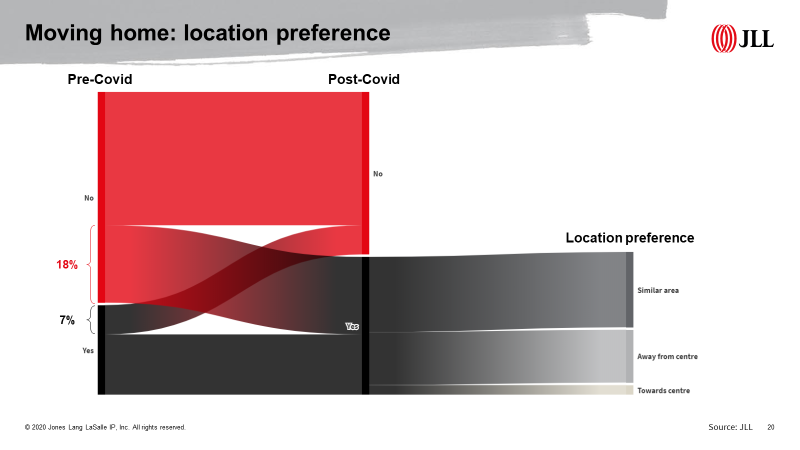We undertook a survey of JLL employees across Europe to assess whether the extended period spent at home due to Covid-19 has altered the way we feel about our homes. In this first of two blogs, we look at the major shifts in perceptions and preferences. The second will unpick changing work from home expectations and how these translate into housing demands.
National lockdowns have been a common government response to concerns over the spread of Covid-19, though their stringency has varied across Europe. Our survey sample includes nearly 2,000 respondents from 15 different countries who all have different experiences of lockdown, but one thing is for sure, their time at home has increased. According to Google’s Mobility Trends reports, time spent in residential settings within our sample countries was, at its peak, anywhere from 29% to 46% higher than the baseline level. 
In this first blog, we look at how more time spent at home has shaped peoples’ opinions of their living arrangements and whether they are now more likely to consider moving as a result.
Moving homes
The amount of time people are spending at home has encouraged households to think about their living arrangements. One solution to this situation, obviously dependent on financial capacity, is to move home.
Only 3 in 10 respondents were looking to move home before Covid-19, with a relatively higher rate for renters (38%) and people aged 35-44 (33%). Split by geography, those in the UK & Ireland were actually less likely to be looking to move (22%) whereas German respondents were the most active prospective movers (33%).
Experiences under Covid-19 lockdowns have changed the landscape. 46% of respondents are now looking to move, though the picture is more muddied at the individual level. One third of those who had been looking are now no longer, perhaps put off by economic uncertainty. Nearly 4 in 10 (37%) of those who had not been looking are now open to moving.

Experiences, and expectations for their work-life balance moving forward, have led people to reconsider where they live. Of those now looking to move, only just over half (55%) are looking to change to a similar location, with 38% looking to move further away from the city centre. Unsurprisingly, the desire for more space and the declining importance of an easy commute (based on an expectation for more home working), means that individuals can prioritise the qualities of the home itself, more than just the location in relation to their workplace. In global cities[1], this proportion increased to 41% and rises again to 45% for the Alpha+ global cities of London and Paris. These larger cities tend to offer better suburban and commuter transport links, indicating that people are not looking for wholesale lifestyle changes, but a slight shift in the kinds of neighbourhoods in which they would like to live.
[1] As defined by GaWC. Alpha++ (London); Alpha+ (Paris); Alpha (Frankfurt, Madrid, Milan, Brussels, Warsaw); Alpha- (Amsterdam, Dublin, Luxembourg, Munich, Prague, Rome, Barcelona, Lisbon)
Changing home priorities
While all those wanting to move may not be able to, our survey does appear to indicate that what we consider to be important in our homes may be changing in light of this shock to our day-to-day lives. Respondents ranked the importance of 14 metrics pre and post Covid-19. The biggest shifts in priorities ranked extremely important were having a personal outdoor space, fast broadband speed and a private workspace.
People’s now intimate relationship with their homes means many are looking to modify and reimagine their living spaces. Overall, 43% of people would like to adjust, with a strong correlation with age: younger people are most likely (50% aged 18-34) compared to older cohorts (23%; 55+). With renters also more likely to want to modify, it points to the conclusion that older home owners have more space and better work from home environments, which is perhaps unsurprising given they already, on average, spend more time working at home.
Top priorities do, however, vary slightly by country. All regions put outdoor space, which could be as little as a balcony or small terrace, and natural light among the top 5 most important factors. Air quality and broadband speed are also seen as important across most regions. Lower down the list of priorities, there is some regional variation: those in Southern Europe, where temperatures are warmer, favour thermal comfort, whereas those in the UK & Ireland, Poland and Benelux want to be close to public outdoor space.
Longer-term implications
After weeks and months of housing markets being frozen, this pent-up desire to move is starting to translate into more enquiries, though the economic challenges are putting the brakes on a massive uptick in transactional activity, at least for now.
Anecdotal evidence from real estate agencies is suggesting that some of these home preference trends have already been borne out in both sales and rental market activity across different European markets. How much these strong preferences translate into concrete and long-term demand shifts is still yet to be determined, but one thing is for sure – the pandemic has heightened an appreciation for good quality homes which meet owner or tenant expectations, which is unlikely to recede.




